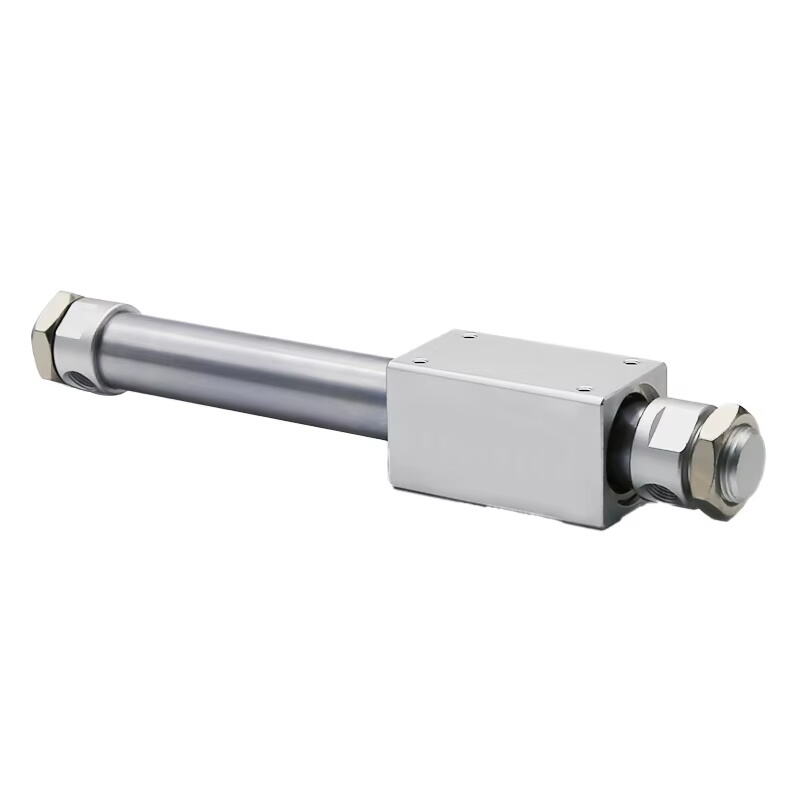Introduction to Cylinders in Mechanical Systems
Essential Role of Cylinders in Fluid Power
Cylinders are vital components in fluid power systems, enabling the transmission of force through hydraulic and pneumatic mechanisms. Their ability to convert fluid energy into mechanical action is indispensable in various applications, ranging from industrial machinery to mobile equipment. Given their significance, choosing the right type of cylinder is crucial. Evidence suggests that improper selection can result in inefficiencies and reduced performance, underscoring the importance of understanding the specific role and function of cylinders in these systems. Understanding the wide range of applications ensures better performance and optimized system design for users.
Basic Operating Principles Across Industries
Cylinders operate by converting fluid energy into mechanical work, showcasing their versatility across numerous engineering disciplines. Key factors such as pressure, stroke length, and load capacity are essential for maximizing cylinder efficiency and longevity. Understanding these fundamentals can prevent common errors in cylinder usage. Industry reports and statistics reveal that a substantial portion of machinery failures are attributed to misuse or errors in the selection of mechanical cylinders. This highlights the need for in-depth knowledge and careful consideration when integrating cylinders into different mechanical systems to ensure durability and optimum performance across varied applications.
Hydraulic Cylinders: Heavy-Duty Fluid Power
Single-Acting vs. Double-Acting Designs
Single-acting and double-acting hydraulic cylinders embody fundamental differences influencing their usage and effectiveness. Single-acting cylinders rely on fluid pressure to facilitate movement in one direction—typically used in simpler systems due to their straightforward mechanism. On the other hand, double-acting cylinders utilize pressure for both extension and retraction, providing greater control and flexibility. This distinction is pivotal, as noted in hydraulic engineering guidelines, which state that selecting the appropriate design can enhance system efficiency by as much as 30%. Understanding these designs is essential for optimizing performance in hydraulic systems, ensuring that engineers and operators can choose the best fit for their specific applications.
Telescopic and Welded Hydraulic Cylinders
Telescopic and welded hydraulic cylinders cater to different operational needs, emphasizing space conservation and structural robustness, respectively. Telescopic cylinders feature multiple stages that allow them to extend significantly, making them ideal for setups with limited installation space, such as dump trucks or shipyard cranes. In contrast, welded hydraulic cylinders boast a robust construction suitable for high-pressure applications, making them indispensable in heavy machinery where durability is paramount. Research highlights that the strategic choice between these designs can significantly optimize space usage and pressure handling capacities, offering tailored solutions across various industrial applications.
Applications in Construction and Mining
Hydraulic cylinders are indispensable in the construction and mining sectors due to their power and reliability. In construction, they are integral to machinery like excavators, loaders, and cranes, enabling these machines to handle massive materials with precision. Mining operations leverage hydraulic cylinders in equipment designed for heavy lifting and intricate maneuvering amid harsh conditions, proving crucial for efficiency and safety in these demanding environments. Statistical insights emphasize their importance, revealing that hydraulic systems can enhance operational efficiency by up to 40% in these industries, underscoring their role in driving productivity and performance improvements.
Pneumatic Cylinders: Compressed Air Efficiency
Tie-Rod vs. Mill-Duty Pneumatic Systems
Tie-rod pneumatic cylinders are celebrated for their lightweight construction and ease of maintenance, making them a go-to choice for less demanding environments. In contrast, mill-duty pneumatic systems are engineered for enhanced durability, suitable for more rigorous applications. These differences are crucial for manufacturers when selecting the appropriate pneumatic system for specific tasks. For example, numerous case studies have shown that when cylinder selection aligns with operational demands, efficiency often improves significantly. Such insights aid in optimizing performance and ensuring longevity in pneumatic applications.
Single/Double-Acting Mechanisms
Pneumatic cylinders, akin to hydraulic counterparts, are designed with single and double-acting mechanisms, each impacting speed and force application. Single-acting cylinders are generally preferred for less demanding applications due to their simplicity. Double-acting cylinders, however, offer more control and versatility, making them suitable for more complex tasks. Industry benchmarks highlight that pneumatic systems exhibit one-third greater reliability when appropriately matched to their operational mechanisms. This indicates that understanding the specific needs of a system can substantially enhance performance and reliability.
Automation and Manufacturing Use Cases
Pneumatic cylinders are key components in the realm of automation technologies, often found in production lines and robotics. Their rapid response times and minimal maintenance requirements are significant contributors to improved productivity within manufacturing environments. According to data from manufacturing sectors, the integration of efficient pneumatic systems has led to a 25% reduction in downtime. This underscores the essential role that pneumatic technologies play in streamlining operations and reducing inefficiencies, thus maximizing output in manufacturing settings.
Electromechanical Cylinders: Precision Control
Electric Motor-Driven Actuation
Electromechanical cylinders are characterized by their use of electric motors for actuation, which provides a level of precision and control unattainable by traditional hydraulic or pneumatic systems. This technology is not only about achieving fine control but also significantly reduces energy consumption. In fact, comparative studies have shown that electromechanical systems can enhance energy efficiency by approximately 50%, presenting a compelling case for their adoption in various industrial applications. As industries pivot towards sustainable and efficient solutions, electromechanical cylinders stand out as a crucial component in enhancing operational efficiency.
Position Sensing and Programmable Features
Position sensors and programmable controls are key elements integrated into electromechanical cylinders, allowing for intricate and precise movements that are essential in modern automation systems. This technological adaptability suits high-tech applications, particularly in cutting-edge manufacturing processes. Experts and reports from automation industry leaders have consistently noted the competitive advantages these systems offer, highlighting their role in advancing manufactural capabilities through precision control. Such advancements not only improve product quality but also streamline operations across complex production lines.
Robotics and CNC Machinery Applications
The utilization of electromechanical cylinders in robotics and CNC machinery is driven by their exceptional accuracy and repeatability. This technology empowers these sectors to execute complex designs and operations that are beyond the capabilities of conventional systems. As current trends indicate a growing inclination towards electromechanical solutions, industries are increasingly recognizing these systems' value in supporting innovative and precision-driven fields. The shift towards incorporating such devices reflects the pressing demand for technologies that can meet the high standards of precision required in today's advanced technological landscape.
Key Differences Between Cylinder Types
Force Output Comparison Chart
Creating a comparison chart of force outputs for different cylinder types offers a visual guide for making informed decisions. This chart highlights how force output varies with cylinder size, operating pressure, and fluid type, helping compare hydraulic, pneumatic, and electromechanical cylinders. For instance, hydraulic cylinders generally deliver high force outputs due to their use of incompressible fluids, unlike pneumatic systems that use compressible air resulting in lower forces. Electromechanical cylinders strike a balance by leveraging electric motors for precise actuation. Research indicates that visual aids, such as charts, can improve decision-making speed by 20% in technical environments, allowing professionals to quickly assess which cylinder type best fits their application needs.
Speed vs. Control Capabilities
The speed and control capabilities of cylinder types starkly contrast, influencing their suitability for specific applications. Hydraulic cylinders are champions in force generation but may compromise on speed. In contrast, pneumatic models provide rapid actuation but with less force control. Electromechanical cylinders, powered by electric drive mechanisms, offer exceptional precision in movement, making them ideal for applications requiring intricate control. Empirical studies suggest that comprehending these dynamics can optimize performance by up to 30%, which underscores the importance of scrutinizing both speed and control considerations meticulously.
Environmental and Maintenance Factors
Environmental factors, such as temperature and humidity, significantly impact cylinder performance and durability. For example, hydraulic cylinders are robust against temperature variations but might face hydraulic fluid maintenance challenges. Pneumatic cylinders, while simple and clean, necessitate frequent inspections due to moisture issues from compressed air. Electromechanical solutions generally offer lower maintenance demands but might require thorough environmental assessments for optimal integration. Engineering maintenance practices recommend adjustments in maintenance strategies based on environmental conditions to maximize the lifespan and efficiency of cylinders in diverse settings.
FAQ
What are the main types of cylinders in mechanical systems?
The main types include hydraulic cylinders, pneumatic cylinders, and electromechanical cylinders, each offering unique benefits suitable for different applications.
How does a hydraulic cylinder differ from a pneumatic cylinder?
Hydraulic cylinders use incompressible fluids for high force generation, while pneumatic cylinders use compressible air, offering fast actuation but lower force output.
Why choose electromechanical cylinders for precision applications?
Electromechanical cylinders provide exceptional accuracy and energy efficiency, making them ideal for precision-driven fields, such as robotics and CNC machinery.
Can environmental conditions affect cylinder performance?
Yes, factors like temperature and humidity can impact performance. It's crucial to choose the right cylinder type and maintenance strategy for the environmental conditions.
What considerations influence the choice of cylinder type?
Key considerations include force output, speed, control capabilities, environmental impact, and specific application needs.
Table of Contents
- Introduction to Cylinders in Mechanical Systems
- Hydraulic Cylinders: Heavy-Duty Fluid Power
- Pneumatic Cylinders: Compressed Air Efficiency
- Electromechanical Cylinders: Precision Control
- Key Differences Between Cylinder Types
-
FAQ
- What are the main types of cylinders in mechanical systems?
- How does a hydraulic cylinder differ from a pneumatic cylinder?
- Why choose electromechanical cylinders for precision applications?
- Can environmental conditions affect cylinder performance?
- What considerations influence the choice of cylinder type?

